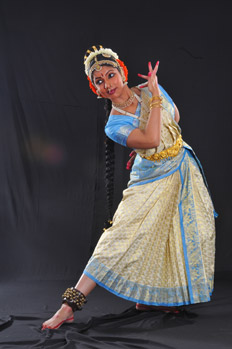Events
September 19, 2011
Staging and studying a 16th-century Indian dance drama

Harshita Mruthinti Kamath as Satyabhama. In the upcoming performance, she will dance as Krishna.
"Bhamakalapam," a 16th-century dance drama from the South Indian dance form of Kuchipudi, is rarely performed in the United States. This month, local audiences have an opportunity to see the drama at Emory's Performing Arts Studio and the Hindu Temple of Atlanta.
Harshita Mruthinti Kamath is a sixth-year doctoral candidate in Emory's Graduate Division of Religion with a focus on South Asian religions. Her dissertation addresses how gender is portrayed in Telugu poetry and performance traditions, using the "Bhamakalapam" character of Satyabhama as her focus.
Jessica Cook, Center for Creativity & Arts editor, spoke with Kamath about the Bhamakalapam story and the upcoming performances.
Satyabhama, one of the wives of the Hindu deity Krishna, elaborates on her experience of love and separation from her divine husband. Why is she such a strong character?
Satyabhama expresses a sense of independence, and self-identity in "Bhamakalapam" as well as other sources, such as classical Telugu literature. For example, "Bhamakalapam" opens with Satyabhama's pravesa daravu, or introductory song, in which she announces that she is the most beautiful amongst all of Krishna's wives, and the only one to have stolen his heart. She is particularly known for her pride, although this trait is balanced with her own anxieties over Krishna's prolonged absence, a theme that continues through the course of the dance drama. She has caught the imagination of Telugi-speaking South Indians for several hundred years as she is presented as a particularly self-assured, proud woman relative to the other female characters in the story of Sri Krishna.
Who are the other characters in relation to Satyabhama? Which character do you perform?
"Bhamakalapam" involves three dancers: Satyabhama, her female confidante Madhavi who shifts to a male character Madhava through the course of the drama, and Krishna. In the upcoming performances, Sasikala Penumarthi, an Emory artist affiliate, will dance Satyabhama, and I will be dancing as Krishna. The character of Madhava/Madhavi will be portrayed by Vedantam Raghavaiah, an artist from a traditional family from the village of Kuchipudi who now lives in Houston.
Traditionally, Kuchipudi was an exclusively male dance form in which men would take on cross-gender guises to "impersonate" female characters. How did men typically portray Satyabhama and how has that changed?
For at least 500 years in Telugu-speaking South India, Kuchipudi brahman males have been donning the female guise, or stri vesam, in order to portray female characters such as Satyabhama. Due to the original prohibition against female performers, brahman male dancers utilized highly stylized gestures and costumes to enact the guise of Satyabhama. The male performer impersonating Satyabhama takes great pains to establish his femininity through elaborate costume, gait and voice modulation. Although women now dominate the contemporary Kuchipudi stage, female impersonation by brahman men remains a characteristic feature of this dance form.
In the mid-20th century, the legendary Kuchipudi dance guru Vempati Chinna Satyam revolutionized Kuchipudi by training women and introducing new dance techniques. In order to allow women the opportunity to portray the character of Satyabhama, Chinna Satyam rechoreographed "Bhamakalapam" with his female students in mind, and taught this version of the drama to a select handful of his most talented students, including Sasikala Penumarthi. In Chinna Satyam's "Bhamakalapam," women not only portrayed the female role of Satyabhama, but also the male role of Krishna, demonstrating the reverse trend of male impersonation in the contemporary period.
What excites you most about the upcoming performances?
While the dance drama has been performed by a select number of performers in India, it is almost never performed in the United States, and will be the first time for many audience members to see it. It has been an incredible experience for me to rehearse for this drama, particularly with my extremely talented guru Sasikala Penumarthi and the gifted supported orchestra.
